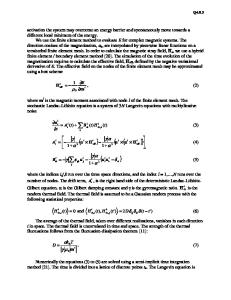Thermal properties of pillared-graphene nanostructures
- PDF / 661,496 Bytes
- 6 Pages / 612 x 792 pts (letter) Page_size
- 27 Downloads / 373 Views
Thermal properties of pillared-graphene nanostructures M. Rifu and K. Shintani Department of Mechanical Engineering and Intelligent Systems, University of Electro-Communications, 1-5-1 Chofugaoka, Chofu, Tokyo 182-8585, Japan
ABSTRACT The thermal conductivities of pillared-graphene nanostructures (PGNSs) are obtained using nonequilibrium molecular-dynamics simulation. It is revealed their thermal conductivities are much smaller than the thermal conductivities of carbon nanotubes (CNTs). This fact is explained by examining the density of states (DOS) of the local phonons of PGNSs. It is also found the thermal conductivity of a PGNS linearly decreases with the increase of the inter-pillar distance. INTRODUCTION Nanocarbon is the generic name to fullerene, carbon nanotubes (CNTs), and graphene etc. Although these nanocarbons have themselves excellent electronic, thermal, and mechanical properties applicable to nanotechnology, nanocarbon hybrids [1] are another trend to be seeked by researchers. A PGNS is one of such nanocarbon hybrids. This three-dimensional (3D) architecture was first designed by Dimitrakakis [2] who imagined its application to hydrogen storage. Almost at the same time, Kondo et al. (2008) showed the possibility of experimentally fabricating PGNSs. A PGNS consists of parallel monolayer graphene sheets and single-walled carbon nanotubes (SWNTs); as pillars, the SWNTs connect the graphene sheets in their out-of-plane direction. Since the thermal conductivities of graphene and SWNTs in the in-plane and axial directions, respectively, are extremely large compared to those of conventional materials, such a 3Dnanostructure is expected to be applicable to thermal treatment in electronic devices. Varshney et al. (2010) investigated the thermal transport in pillared-graphene, and concluded that the length of pillars and the inter-pillar distance are the two parameters governing its thermal transport. They constructed pillar-graphene junctions by combining seven-membered and six-membered rings of carbon atoms. However, pillar-graphene junctions can also be constructed by combining five-membered and eight-membered rings. Furthermore, they assumed only one kind of geometrical arrangement of pillars although there are many kinds of the arrangement. In this paper, we address the effects of atomic configurations at pillar-graphene junctions and geometrical arrangement of pillars on the thermal transport of PGNSs by means of nonequilibrium molecular-dynamics (NEMD) simulation. The density of states of thermal phonons is also examined in order to explain the thermal conductivity of pillared-graphene is much smaller than of CNTs or graphene. The effective thermal conductivities of PGNSs in the out-of-plane direction are calculated. The outcome will be useful to thermal design of nanodevices.
SIMULATION METHOD AND MODEL The large-scale atomic/molecular massively parallel simulator (LAMMPS) code [5] is employed. The nonequilibrium molecular-dynamics method is adopted to obtain the thermal conductivities of PGNSs. The
Data Loading...











